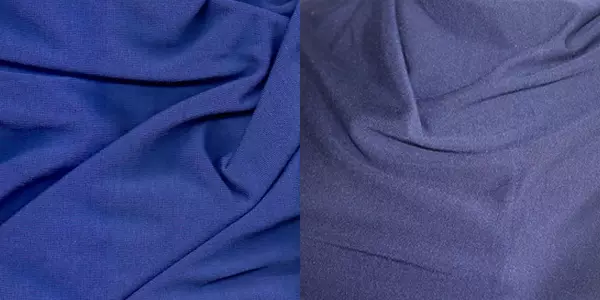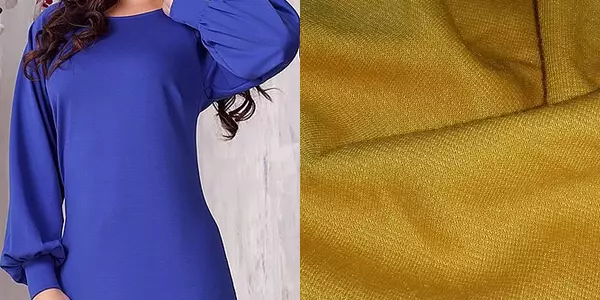The convenience of warm, soft and elastic knitted products was not subject to questioned since this type of needlework was invented, subsequently mechanized. However, until the beginning of the last century, knitwear, including widespread jersey, was used mainly for warm clothes and work clothing. The talent of Great Mademoiselle Chanel contributed to the fact that knitted jackets, dresses and costumes have become a mandatory thing in the wardrobe of elegant women. Since then, under the present, designers pay great attention to the improvement of the types of knitted textiles. One of these widespread materials is Milano fabric, which combines elegance, goodness and convenience.
What is Milano?

Immediately, there should be a reservation that under similar names in the tissue market there are two different material. Sometimes under the same name, there is a high-quality furniture velor, which is also called "Milan" or Milan. As for Milano, this tissue is knitwear, and may include in its composition:
- wool;
- cotton;
- silk;
- viscose;
- polyester;
- Elastane;
- spandex.
As a rule, Milano has a mixed composition of fibers. The peculiarity of these knitted webs is quite thick threads and very dense weave, so that they hold the form very well and do not appear when . The canvases have a beautiful matte surface, they are manufactured as monophonic and stuffed. Depending on the thickness, the nature of the initial raw materials and external design, this fabric has many varieties. The most common varieties of Milano are:
- Jersey, classic tight knitwear, often with a predominance of woolen fibers;
- Academician, which includes mainly viscose;
- Punto is the most common blended material with a polyester predominance;
- Roma is a rather thin cloth with the addition of cotton.
Article on the topic: Pepple Crochet Pig: Master Class for Knitting Little Hat
Application and properties
It can be argued that this knitwear is universal in the manufacture of practical and beautiful clothes for both adults and children. A huge variety of structures, composition and colors makes Milano suitable for any garrobe object, and its high density allows you to form finishing parts in the form of volumetric folds, various assemblies, volanes, etc. The same properties contribute to the widespread use of this material when interior design: for screens, curtains, covered, covers for furniture and other types of home textiles.
The main properties of such products are:
- high density;
- extension, especially when adding spandex;
- resistance to deformation, including under constant loads;
- the ability to keep the form well and beautifully facilitate the figure;
- the possibility of creating volumetric and relief structural elements;
- a variety of colors and prints;
- softness and comfort;
- Beauty and elegance;
- The ability to air exchange is even the most densely canned;
- The ability to keep warmly well;
- durability;
- Failure.
A slim knitwear made of silk and spandex viscose is ideal for a beautiful and comfortable underwear.
Cotton fibers, viscose and a small thickness of the Roma fabric make it very suitable for summer dresses, blouses, t-shirts, tops, and the addition of Elastane contributes to good fit of the products from it.

Milano Punto material is characterized by a very beautiful matte surface, great softness and elasticity and is considered the most elegant variety of this material, it is widely used for everyday and elegant female dresses and costumes, blouses, golf, losine, as well as for elegant children's clothing. Depending on the thickness and composition, the products from Punto can be suitable for any season.
Academician and Jersey suitable for dense closed dresses, cardigans, costumes, trousers and jackets, and tight woolen knitwear are used for warm and comfortable overhead clothes.
It should be remembered that Milano is very durable and is able to look like "as new" for a long time, therefore, when creating clothes from it, designers prefer simple and elegant models that will not lose their relevance over the years.
How to care?
Caring for mixture fabrics is simple, and high elasticity of Milano and its ability to resist mechanical impacts contribute to the fact that these knitwear will retain their attractiveness and after a large number of styrices. Of course, before performing washing, you need to carefully study the description of the fabric and the accompanying manufacturer's instructions.
Article on the topic: How to tie a knit to the knit from the angle with a detailed description and schemes
Synthetic fibers, which are mandatory included in these materials, it is recommended to wash in warm water and using high-quality detergents without bleaching, and the durable structure of the web allows the use of machine spinning and drying. This fabric is practically not fermented, but it is well tolerating the iron at a temperature of not over 110 degrees.
